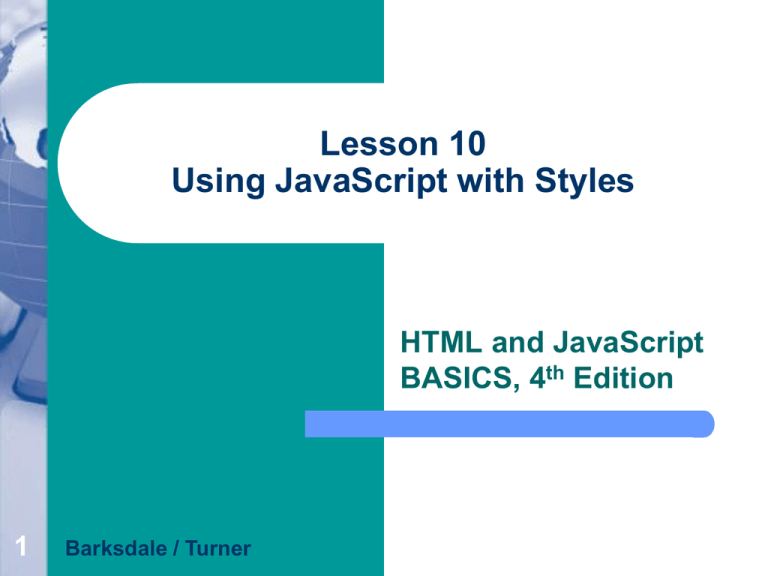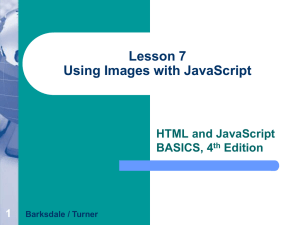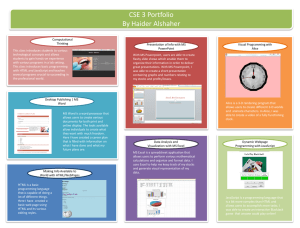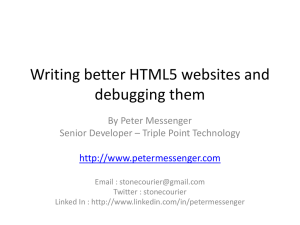Lesson 10 Using JavaScript with Styles
advertisement

Lesson 10 Using JavaScript with Styles HTML and JavaScript BASICS, 4th Edition 1 Barksdale / Turner Objectives Lesson 10 Define a simple frame-based style viewer. Make your style viewer functional. Define a simple frame-based document viewer. Make your document viewer functional. Create a dynamic style class viewer. 2 Barksdale / Turner HTML and JavaScript BASICS 4E Vocabulary Lesson 10 element getElementById() getElementsByTag Name() id 3 Barksdale / Turner location render style style viewer HTML and JavaScript BASICS 4E Defining a Style Viewer Lesson 10 4 The HTML style attribute can be applied to virtually any HTML tag to describe how you want the Web browser to display that portion of the Web page. Although styles are by no means limited to text, applying a style to an HTML tag is one of the most common ways in which styles are applied. Barksdale / Turner HTML and JavaScript BASICS 4E Defining a Style Viewer (continued) Lesson 10 5 The term render simply means to display with the proper attributes applied. An element is just an HTML tag, and once you have identified the element you need to modify, you make it accessible to JavaScript by assigning it an identifying name with the id attribute. Barksdale / Turner HTML and JavaScript BASICS 4E Defining a Style Viewer (continued) A style viewer is a simple tool that allows users to specify a style, apply the style, and then view the results. Lesson 10 Frame-based style viewer 6 Barksdale / Turner HTML and JavaScript BASICS 4E Making Your Style Viewer Functional Lesson 10 7 If a JavaScript event occurs in one frame and the effect of the event is within the same frame, then the JavaScript code should reside in the same frame file. If a JavaScript event occurs in one frame and affects an object or element in a different frame, the code can often be kept to its simplest form if it is defined in the top-level frameset file. Barksdale / Turner HTML and JavaScript BASICS 4E Making Your Style Viewer Functional (continued) Lesson 10 8 In order for JavaScript code to access an HTML tag with an id attribute, a corresponding JavaScript method called getElementById() must be invoked. This method accepts a single parameter, the id of the HTML element you want to access. Barksdale / Turner HTML and JavaScript BASICS 4E Defining a Frame-Based Document Viewer A simple document viewer that moves hyperlinks and headers out of the original HTML document and places them in their own frame adds functionality to a Web page. Lesson 10 9 Barksdale / Turner HTML and JavaScript BASICS 4E Defining a Frame-Based Document Viewer (continued) Lesson 10 10 As shown in Stepby-Step 10.3, the document viewer approach makes the H2 headers more accessible and highlights the active header. Barksdale / Turner Frame-based document viewer HTML and JavaScript BASICS 4E Making Your Document Viewer Functional The process of making a document viewer Web page functional is similar to making your style viewer functional. Lesson 10 Functional document viewer— Fancy Fonts selected 11 Barksdale / Turner HTML and JavaScript BASICS 4E Making Your Document Viewer Functional (continued) Lesson 10 12 The JavaScript code in this section uses the getElementById() method to identify and access the modified HTML elements. A new function uses the JavaScript getElementsByTagName() method to reference an array of HTML elements to which a cascading style has been applied. The location property simply contains the URL of the current HTML document. Barksdale / Turner HTML and JavaScript BASICS 4E Creating Dynamic Content with JavaScript Style Classes Lesson 10 13 You can define many different style attributes in a style class within a Cascading Style Sheet. The style class is then applied, by means of the class attribute, to an HTML element, and all of the attributes in the class take effect simultaneously. Barksdale / Turner HTML and JavaScript BASICS 4E Creating Dynamic Content with JavaScript Style Classes (continued) JavaScript can accomplish the same effect by changing the style class assigned to a Web page element. Lesson 10 Functional style class viewer— final state 14 Barksdale / Turner HTML and JavaScript BASICS 4E Lesson 10 Summary 15 In this lesson, you learned: How to define a simple frame-based style viewer. How to make your style viewer functional. How to define a simple frame-based document viewer. Barksdale / Turner HTML and JavaScript BASICS 4E Summary (continued) Lesson 10 How to make your document viewer functional. How to create a dynamic style class viewer. 16 Barksdale / Turner HTML and JavaScript BASICS 4E









